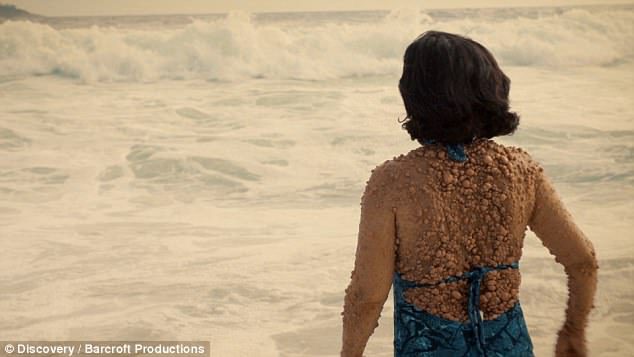Covered in thousands of bubble-like tumors on her body, this mother says that she has learned to love how she looks and is proud to be on the beach in a swimsuit.
When she met her husband-to-be, Jose, she said he ‘fell in love’ with her lumps.
Sandra De Santos, a 53-year-old woman from Rio de Janeiro, Brazil, was diagnosed as a teenager with neurofibromatosis type-1 (NF1), a genetic condition that affects the skin and nervous system.
The condition is fairly common, affecting about one-in-three thousand births, in varying levels of severity.

Unfortunately, Sandra says the tumors covering her body from head to toe have been passed on to three of her four children.
Tragically, De Santos’s second child succumbed to his disease at just six-years-old when his neurofibroma turned cancerous — something known to occur in only 10% of people who suffer from this disease.
Sandra recounts her realization that her son’s death was in fact caused by the disease saying: “I always asked the doctors if it was due to my condition, they said it wasn’t related to it. But when he died I read on his death certificate: “sarcoma due to neurofibromatosis”.
“I became quite sad for a long time. I have three kids, two have the condition. But they look to me as an example, so I keep going,” she said.

DIAGNOSIS
Sandra says that until her teen years, neither her nor her parents recognized any health problems.
The condition is known to show signs at birth and include pale coffee-colored patches called cafe au lait spots, and sometimes benign lumps called neurofibromas.
Sandra was diagnosed in the 1970’s, at a time where doctors and scientists knew very little about the disease.
She said: “Everyday I woke up, I’d notice a new lump. I saw myself as being different.
“Despite this, nothing’s stopped me from doing things. I always dated. I started dating at 17, and I dated a lot. I kissed a lot. I went to the balls a lot.”
Sandra’s torso was completely covered by the time she was in her mid-twenties. Then they started to grow on her arms and face.
She met her current husband Jose in this timeframe.
According to Sandra, he embraced her condition.

Sandra De Santos and Husband, Jose.
“He fell in love with my lumps. He realized I was really unique and decided to go for it. He stayed with me. We’ve been together ever since. We dated, got engaged, then married, it’s been 27 years,” she said.
THEIR CHILDREN’S STRUGGLES
Sandra and Jose have a 21-year-old son named Sandro, who is still learning to cope with his growing number of tumors.
Their youngest child Luana is 16-years-old, and while she has many cafe au lait spots, so far, no tumors have developed.
Luana said: “I have the same disease my mother does, but it never gets in my way. Mum taught me not to care, to see it as something normal. If I become like her, I don’t care.”

NEUROFIBROMATOSIS FACTS
Neurofibromatosis is a genetic condition where tumors begin to grow along the nerves.
There are two types of this condition.
Type 1 affects one in 3,000 births. Its symptoms and severity have a wide range but it typically causes the coffee-colored patches and lumps under the skin which are not cancerous.
Type 2 affects one in approximately 33,000 births, causing non-cancerous tumors as well but can also lead to gradual hearing loss, tinnitus, and decreased balance.
Learning difficulties are usually present in both types.
While there is no cure, surgery can be performed to remove the lumps.
At this time, there is no cure for NF1. The only treatment that Sandra has received is having her tumors removed.
David Azulay, Dermatology Professor explained: “The most important thing for Sandra is to live her life as normally as possible. With hundreds of tumors, it’s hard to remove them all. But when she gets bothered by one, she has surgery.”
Though Sandra’s tumors are not painful, it hurts to have them dug out because they are made up of a complex mass of nerve fibers, connective tissue, and tiny blood vessels. A local anesthetic is used while surgery is performed.
Such a complex genetic condition like neurofibromatosis type 1 is still only it’s early stages of finding a cure.
Sandra said: “Of course I want to find a cure. Maybe not for me, but for my children.”
If you found this article to be interesting, please share with friends and family by clicking the button below.
Source: dailymail.co.uk




